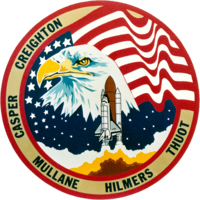STS-36
 | |
| Dane misji | |
| Indeks COSPAR | 1990-019A |
|---|---|
| Zaangażowani | |
| Oznaczenie kodowe | STS-36 |
| Pojazd | |
| Wahadłowiec | |
| Załoga | |
 Od lewej: Pierre J. Thuot, John H. Caster, John H. Creighton, Richard M. (Mike) Mullane i David. C. Hilmers | |
| Dowódca | |
| Start | |
| Miejsce startu | |
| Początek misji | 28 lutego 1990, 07:50:22 UTC |
| Orbita okołoziemska | |
| Apogeum | 204 km |
| Perygeum | 198 km |
| Okres orbitalny | 88,5 min |
| Inklinacja orbity | 62° |
| Lądowanie | |
| Miejsce lądowania | |
| Lądowanie | 4 marca 1990 18:08:44 UTC |
| Czas trwania misji | 4 dni, 10 godz, 18 min, 22 sek |
| Przebyta odległość | 3 089 280 km |
| Liczba okrążeń Ziemi | 72 |
| Program lotów wahadłowców | |
STS-36 (ang. Space Transportation System) – szósty lot amerykańskiego wahadłowca kosmicznego Atlantis. Była to trzydziesta czwarta misja w ramach programu lotów wahadłowców[1].
Załoga
- John Creighton (2)*, dowódca (CDR)
- John Casper (1), pilot PLT)
- Richard "Mike" Mullane (3), specjalista misji 1 (MS1)
- David Hilmers (3), specjalista misji 2 (MS2)
- Pierre Thuot (1), specjalista misji 3 (MS3)
- *(liczba w nawiasie oznacza liczbę lotów odbytych przez każdego z astronautów)
Parametry misji
- Masa:
- startowa orbitera: utajniona
- lądującego orbitera: 84 912 kg
- ładunku: 19 600 kg[3]
- Perygeum: 198 km
- Apogeum: 204 km
- Inklinacja: 62,0°
- Okres orbitalny: 88,5 min
Cel misji
Wojskowa misja wahadłowca – umieszczenie na orbicie satelity rozpoznania fotograficznego typu Key Hole – KH 11-10[3]. Satelita ten prawdopodobnie uległ awarii po umieszczeniu na orbicie[3][1].
Zobacz też
Przypisy
- ↑ a b c Tomáš Přibyl: Dzień, w którym nie wróciła COLUMBIA. Bielsko-Biała: Wydawnictwo >DEBIT<, 2003, s. 164. ISBN 83-7167-224-1.
- ↑ Robert Godwin: Space Shuttle. Warszawa: Prószyński Media Sp. z o.o., 2011, s. 61, seria: Historia podboju Kosmosu. ISBN 978-83-7648-973-5.
- ↑ a b c KH 11-10 (ang.). W: NSSDC Master Catalog [on-line]. NASA. [dostęp 2014-06-01].
Linki zewnętrzne
- podsumowanie misji STS-36 na stronie NASA (ang.)
- Mark Wade: STS-36 (ang.). W: Encyclopedia Astronautica [on-line]. [dostęp 2017-07-23].
- Spaceflight mission report: STS-36 (ang.). W: Spacefacts [on-line]. [dostęp 2017-07-23].
Media użyte na tej stronie
The flag of Navassa Island is simply the United States flag. It does not have a "local" flag or "unofficial" flag; it is an uninhabited island. The version with a profile view was based on Flags of the World and as a fictional design has no status warranting a place on any Wiki. It was made up by a random person with no connection to the island, it has never flown on the island, and it has never received any sort of recognition or validation by any authority. The person quoted on that page has no authority to bestow a flag, "unofficial" or otherwise, on the island.
STS-36 Mission Insignia
The STS-36 crew portrait features 5 astronauts who served in the 6th Department of Defense (DOD) mission. Posed near the Space Shuttle Orbiter Discovery are (left to right) Pierre J. Thuot, mission specialist 3; John H. Caster, pilot; John H. Creighton, commander; Richard M. (Mike) Mullane, mission specialist 1; and David. C. Hilmers, mission specialist 2. The crew launched aboard Atlantis on February 28, 1990 at 2:50:22am (EST).


